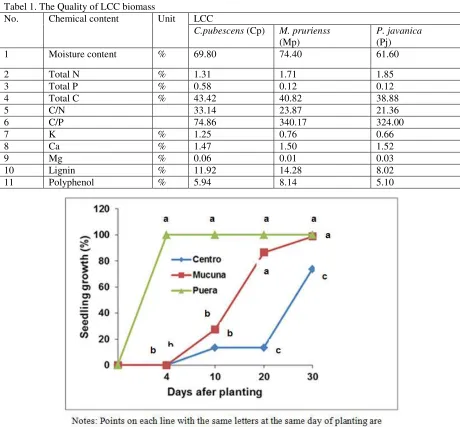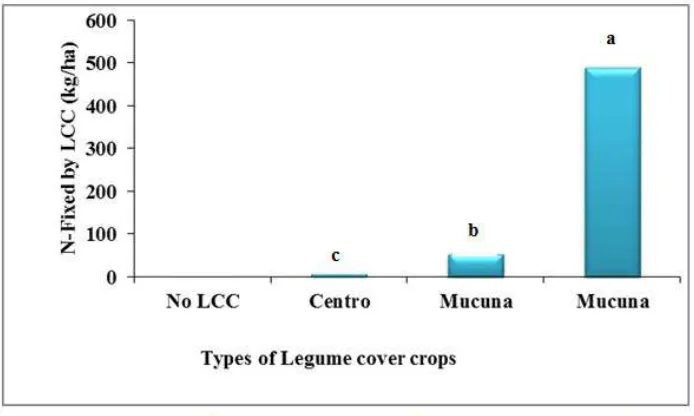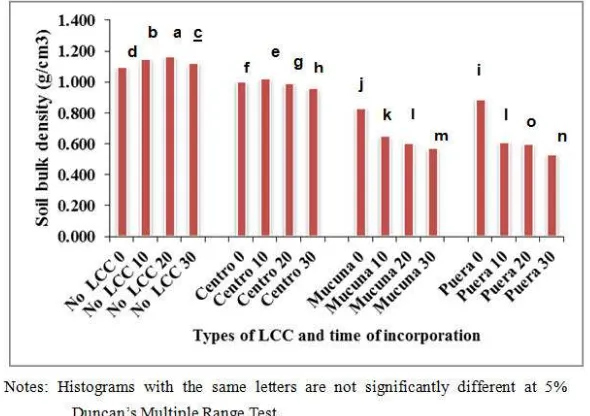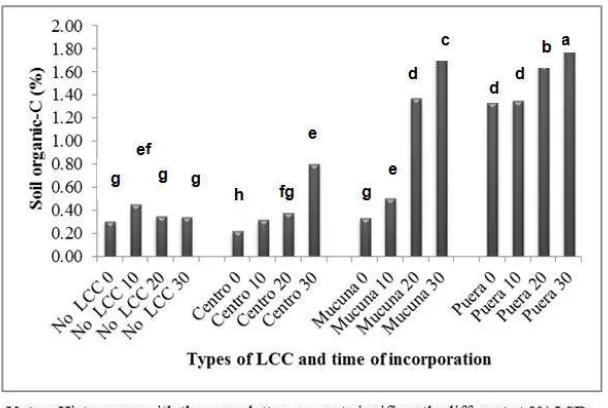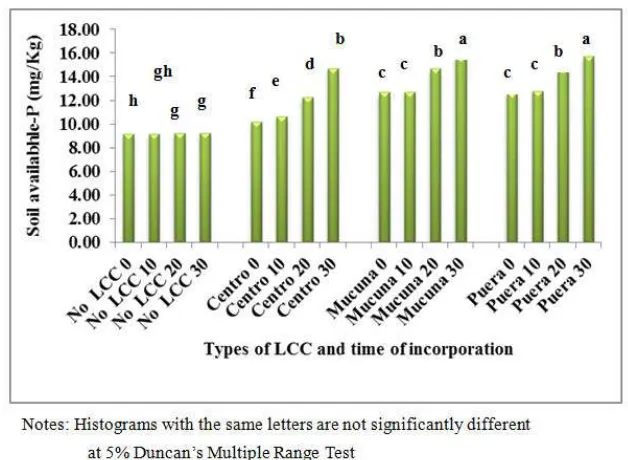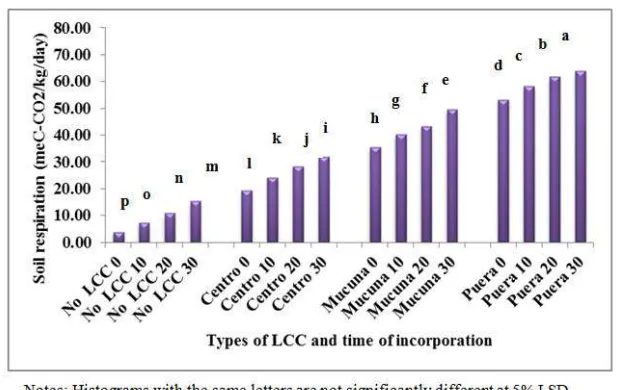Biomass of Various Tropical Legume Cover Crops Increase Soil
Quality of Dryland Soils in Badung Bali, Indonesia
I Gusti Ayu Mas Sri Agung1 I Ketut Sardiana1 I Gusti Made Oka Nurjaya2* 1.Faculty of Agriculture, Udayana University, Bali, Indonesia
2.Faculty of Mathematic and Natural Sciences, Udayana University, Bali, Indonesia * E-mail of the corresponding author: sri_agung@ymail.com
The research was funded by the Directorate General for Higher Education of Republic of Indonesia and the Udayana University through its research and service institution (LPPM), BOPTNYear 2013.
Abstract
Two field experiments were conducted to study the effects of tropical legume cover crops on soil quality in dryland farming areas at Angantaka village, Badung regency, Bali Province of Indonesia from June to November 2013. In the first experiment, three tropical legume cover crops (LCC) (Centrosema pubescens L.(Cp),Mucuna pruriens L.(Mp) and Pueraria javanica L.(Pj)) and one control (without LCC) were arranged in a randomized complete block design with four replicates. Variables measured were the quality of LCC biomass, C-absorbed and fixed-N by LCC. The LCCs were harvested after three months, which were then incorporated into the soil according to the treatments set for the second experiment. Design for the second experiment was a Split-plot with four replicates, where residues (biomass) of three LCC (results of the first experiment) were assigned as the main plot and four times of biomas incorporation (0,10, 20 and 30 days) as the subplot. Results showed that Pj
was the best LCC crop among others (Cp and Mp) due to its highest quality. Pj also hadthe highest absorbed-carbon (58.50 t ha-1), fixed-N (490.21 kg ha-1), biomass FW and DW (304.83 and 116.99 t ha-1) among LCC species. The treatment of Pj with 30 days biomass incorporation significantly improved the soil quality as indicated by the highest soil moisture content (40.25%) and porosity (79.90%), organic-C (1.95%), total N (0.09%), available-P (15.71 mg kg-1), exchangeable-K (2.07 mg kg-1) and soil respiration (63.94 meC-CO
2 kg -1day-1 ).
Keywords: Biomass, Tropical legume cover crop, Soil quality
1. Introduction
In the tropic, farm lands with intensive cultivation without conservation efforts will result in 60-80% loss of organic carbon (Lal, 2006). Therefore, serious efforts are needed to increase soil organic carbon and finally the soil quality in drylands to achieve sustainable food crop productions. Soil physical, chemical and biological characteristics are indicators of soil quality (USDA, 1996).
One of the effort is the use of legume cover crops in crop farming system as a catch crop or fill crop during fallow (Dinga et al., 2006; Sarrantonio, 2007; Steenwerth and Belina, 2008; Acosta, 2009; Wang et al., 2010; Olson et al., 2010). Cover crop is a plant specially planted to cover the soil from erosion damage and to improve physical and chemical characteristics of the soil. Legume over crops has faster growth, adaptive to to low soil fertility, soil nitrogen supplier, absorb carbon effectively through photosynthesis activity, source of soil organic matter through biomass produced, and has higher biomass quality compared to non-legume species. In the long term, legumes contribute to maintain soil carbon content and soil quality improvement sustainably (Steenwerth et al., 2008; Wang et al., 2010; Olson et al., 2010). There are many tropical legume cover crops and used in orchards and also as forage such as Centrocema pubescens, Mucuna pruriens, Crotalaria juncea, Pueraria javanica, Phaseolus lunatus and others.
As fallow crops the use of soil cover crops play important roles in scavenging soil nutrients and save them temporarily until finally return them back to the soil, then to increase nutrients and organic carbon and to be available for the next crops. As soil cover they function to (1) resist or reduce damage action of rainfall drops and run-off on the soil surface, (2) increase soil organic matter through fallen dead stems and twigs.
of crops. Therefore the present experiments were conducted to evaluate the potential of tropical LCC as cheap and easy to manage for improving soil quality in the areas.
2. Materials and methods
2.1 Study Area
Two field experiments were conducted from june to november 2013 at the dryland farming areas of angantaka village, badung, bali (008° 44' 45"s-115°10' 09"e, 3 m above sea level). The land was abandoned for long time and the soil has a very low organic-c (0.45 %), n (0.005%), available p (12.62 mg kg-1) . Meanwhile the exchangeable-k (1.18 mg kg-1), was high but soil ph was neutral (6.9). Soil moisture content at field capacity was 20.84% and soil texture was clayly silt (soil chemical laboratory of faculty of agriculture brawijaya university, malang, 2013). The analysis of lcc biomass, soil physical and chemical properties were conducted in the laboratory of soil biology, chemical and physics, faculty of agriculture brawijaya univeristy, malang (2013). Analysis of soil biological properties was conducted in laboratory of soil science, faculty of agiculture udayana university, denpasar (2013).
The first experiment was conducted to study the potential of various legume cover crops, which was conducted from June to August 2013. Experiment II was conducted from September to November 2013 to study the residual effect of LCC biomass on soil quality. In the first experiment, three tropical LCC viz. Centrosema pubescens L. (Cp), Mucuna pruriens L.(Mp) and Pueraria javanica L.(Pj) and one control (No LCC) were arranged in a randomized complete block design with four replicates. Variables measured were biomass production and the quality of LCC species, absorbed-C and fixed-N by LCC. The LCCs were harvested after three months, and the biomass were then incorporated into the soil according to the treatments set for the second experiment.
Design for the second experiment was a Split-plot with four replicates, where residues (biomass) of three LCC (results of the first experiment) were assigned as the main plot and four biomas incorporation periods (0,10, 20 and 30 days) as the subplot. Variable of soil physical (soil moisture content, bulk density and porosity), chemical (organic-C, total N, available-P and exchangeable-K,) and biological quality (soil microbe respiration) of the soil were measured after 30, 20, 10 and 0 days biomass incorporation. Soil moisture content, bulk density and porosity were respectively measured using the method of gravimetry, organic-C (Walkley and Black), N (Kjeldahl), available-P (Bray II) and exchangeable-K (NH4OAc1N pH 7). Plate method was used to measure soil microbe respiration.
2.2 Statistical analysis
Statistical analysis was conducted using Cohort and MstatC computer software and comparation of means were done using Duncan’s Multiple range test and Least Significant Different analysis at 5% level (Gomez and Gomez, 1984). Data were transformed where necessary. Figures were drawn using Excel software.
3. Results and discussion
3.1 LCC Biomass Quality and Production
Results of biomass quality analysis (experiment I) showed that Pueraria javanica L. or Pj was the best species among the others (Mucuna pruriens L. and Centrosema pubescens L.) due to its best quality such as higher moisture content (72.06%), total N (3.85%), total P (0.25%), K (1.66%), total C (49.88%), Ca (3.58%), but lower C/N ratio (9.36) and C/P ratio (364.00) (Table 1). Additionally, Pj also hadthe highest absorbed carbon(58.50 t ha-1) (Fig.2) and fixed N (490.21 kg ha-1) (Fig.3). PJ gave the highest biomass production (FW and DW of 304.83 and 116.99 t ha-1) (Fig.1) compared to the other species. Hairiah et al. (2003) reported that LCC could provide 2-3 t ha-1 organic materials at the age of 3 months and produced 3-6 t ha-1 when was left for 6 months. In the present experiment the LCC produced higher organic materials in 3 months.
Tabel 1. The Quality of LCC biomass
No. Chemical content Unit LCC
C.pubescens (Cp) M. prurienss
(Mp)
P. javanica
(Pj)
1 Moisture content % 69.80 74.40 61.60
2 Total N % 1.31 1.71 1.85
3 Total P % 0.58 0.12 0.12
4 Total C % 43.42 40.82 38.88
5 C/N 33.14 23.87 21.36
6 C/P 74.86 340.17 324.00
7 K % 1.25 0.76 0.66
8 Ca % 1.47 1.50 1.52
9 Mg % 0.06 0.01 0.03
10 Lignin % 11.92 14.28 8.02
11 Polyphenol % 5.94 8.14 5.10
3.2 LCC seedling growth, biomass fresh and dry weight, absorbed-C and fixed-N
Pj species had the earliest and fastest growth compared to the other LCC species. The seedlings had already 100% emerged at four days after sowing, while the other species achieved that 30 days after planting (Fig.1). Pj
species also had the the highest biomas FW and DW (304.83 and 116.99 t ha-1) (Fig.2), absorbed-C (58.50 t ha-1) (Fig.3) and fixed-N (490.21 kg ha-1) (Fig.4), among all LCC species. Those qualities of Pj species were significantly (P<0.05) higher than those of Mp and Cp species.
Fig. 3. C-absorbed by Legume cover crops
Fig. 4. N Fixed by Legume cover crops
3.3 Effect of LCC biomass incorporation 3.3.1 Soil Physical quality
Fig. 5. Soil moisture content under each LCC type and times of residue incorporation
PJ species used in the present experiment had the lowest C/N ratio (9.36) compared to the other LCC types (Table 1), therefore could have been easily decomposed by soil organisms. The C/N ratio determines the rate of decomposition, because carbon (C) and nitrogen are important for microorganisms to conduct the decomposition process. Carbon is needed by microorganisms as the energy source and nitrogen as proteins. A biomass with high C/N ratio is slower to be decomposed (Sulistiyanto et al., 2005). High C/N ratio indicates low N in the organic materials therefore the available N will first be used for their physiological requirements.
Organic materials with lower C/N ratio (such as legumes) generally undergo faster decomposition with 50% materials have been decomposed in three weeks (Hairiah and Murdiyarso, 2007). This situation could have been the reason for the effect of biomass incorporated into the soil in the present experiment, which was more significant after 30 days compared to 10 and 20 days of incorporation.
Fig. 7. Soil porosity under each LCC type and times of residue incorporation
3.3.2 Soil chemical quality
Among the treatments, Puera 30 resulted in the highest soil organic-C (1.75%) (Fig. 8), total N (0.09%) (Fig. 9), available P (15.71 mg kg-1) (Fig. 10) and exchangeable K (2.07 mg kg-1) (Fig. 11). The highest value of those chemical components were due to the highest chemical quality of Pueraria javanica (Tabel 1), which completely released those nutrient at 30 days of incorporation. Higher soil organic-C, total N, available-P and exchangeable-K under the treatment of Puera 30 was associated with high quality (Tabel 1) and production of Pj biomass (Fig.2 and Fig.3). In the present study, the decomposition was believed to occur before 30 days after biomass incorporation and the nutrients were released more than 50% by the time of 30 days after biomass incorporation, especially with the good quality biomass of LCC such as Pueraria javanica L.(Pj).
Fig. 8. Soil organic-C under each LCC type and times of residue incorporation
3.3.3 Soil biological quality
addition, lower lignin and polyphenol contents in PJ species (Table 1) could increase the rate of decomposition. High lignin and polyphenol contents in organic materials would inhibit the mineralization process due to their protein binding that determine the easiness of decomposition by soil microbes (Stevenson 1994; Hadyanto et al., 1997).
Fig. 9. Soil total N under each LCC type and times of residue incorporation
Fig. 11. Soil exchangeable K under each LCC type and times of residue incorporation
Fig. 12. Soil respiration under each LCC type and times of residue incorporation
4. Conclusion
Species of Pueraria javanica L. was the best and suitable LCC to improve soil quality among all LCC species. The biomass residues of Pueraria javanica L. significantly improved the soil quality through increasing physical, chemical and biological quality of the soil at 30 days after biomass incorporation.
References
Acosta, S.I.C. (2009). Promoting the use of tropical legumes as cover crops in Puerto Rico. Master Thesis. Mayaguez University of Puerto Rico. 67 p.
Blair, G.., Chapman, .L, Withbread, A.M., Coelho, B.B., Larsen, P. & Tissen, H. (1998). Soil carbon change resulting from sugarcane trash managemen at two location in Queensland, Australian and in North-East Brazil. Australian Journal of Soil Research, 38, 87-881.
Bot, A., & Benites, J. (2005). The importance of soil organic matter. Key to Drought-resistant Soil and Sustained Food and Production. FAO Soils Buletin 80. Food and Agricukture Organization of the United Nations. Rome, 71p.
Dinga, G., Liub, X., Herbertc, S., Novakd, J., Dula, A., & Baoshan X. (2006). Effect of cover crop management on soil organic matter. Geoderma, 130, 229-239.
Hairiah, K & Murdiyarso, D. 2007. Alih Guna Lahan Dan Neraca Karbon Terrestrial. Bahan Ajar ASB3. World Agroforestry Centre (ICRAF) Southeast Asia (In Bahasa Indonesia).
Hairiah, K., Utami, S.R., Lusiana, B., & van Noordwijk, M. (2003). Neraca hara dan karbon dalam sistem agroforestri: Dalam: Pengantar Agroforestry. Bahan Ajar 6. Word Agroforestry Centre (ICRAF). Bogor. pp.105-124. (In Bahasa Indonesia).
Handayanto, E., Cadisch, G., & Giller, K.E. (1997). Regulating N mineralization from plant residues by manipulation of quality. In: Cadisch G, Giller KE. eds. Driven by nature plant litter quality and decomposition. CAB International, Wallingford. pp. 175-185.
Komatsuzaki, M., & Syuaib, F.M. (2010). Comparison of the Farming System and Carbon Sequestration between Conventional and Organic Rice Production in West Java, Indonesia. Sustainability, 2(3), 833-843 Laboratory of soil chemical of Faculty of Agriculture University of Brawijaya Malang. (2013). Results of soil and plant analysis of Angantaka soils.
Laboratory of soil science of Faculty of Agriculture Udayana University Denpasar. (201). Results of soil physical analysis of Angantaka soils.
Lal, R. (2006). Enhancing crop yields in the devoloping countries through restoration of the soil organic carbon pool in agricultural lands. Land Degradation Development, 17, 197-209.
Olson, K.R., Ebelhar, S., Lang, A., & James, M. (2010). Cover crop effects on crop yields and soil organic carbon content. Soil Science, 175, 89-98.
Palm, C.A, Myers, R.J.K., & Mandawa, S.M. (1997). Combined use of organic and inorganic nutrient sources for soil fertility maintenance and replenishment. Soil Science Society of American Journal (Spec. Publ.51), 193-217.
Rachman, A., Dahria, A., & Santoso, J. (2008). Pupuk Hijau. Dalam: Simanungkalit RDM, Suriadikarta DA, Saraswati R, Setyorini D, Hartatik W. eds. Pupuk Organik dan Pupuk Hayati. Balai Besar Litbang Sumberdaya Lahan Pertanian. Badan Penelitian dan Pengembangan Pertanian. Bogor. (In Bahasa Indonesia), 41-58.
Sarrantonio, M. (2007). Building Soil Fertility and Tilth Cover crops. In: Managing Cover Crops Profitably (Third Edition): Handbook Series Book 9. Published by the Sustainable Agriculture Network, Beltsville, MD A publication of the Sustainable Agriculture Network with funding by the Sustainable Agriculture Research and Education Program of CSREES, U.S.Department of Agriculture.
Steenwerth, K., & Belina, R.J. (2008), Cover crops enhance soil organic matter, carbon dynamics and microbiological function in a vineyard agroecosystem. Applied Soil Ecology, 40, 359- 369.
Stevenson, F.J. (1994). Humus Chemistry: genesis, composition, reactions. 2nd ed. New York: Wiley
Sulistiyanto, Y., Rieley, J.O, & Lemin, S. H. (2005). Laju dekomposisi dan pelepasan hara dari serasah pada dua sub tipe hutan rawa gambut di Kalimantan Tengah. Tropical Forest Management Journal XI (2) .(In Bahasa Indonesia), 1-14.
USDA. (1996). Soil Quality Indicators: Organic Matter. Soil Quality Information Sheet. USDA Natural Resources Conservation Service April 1996.
